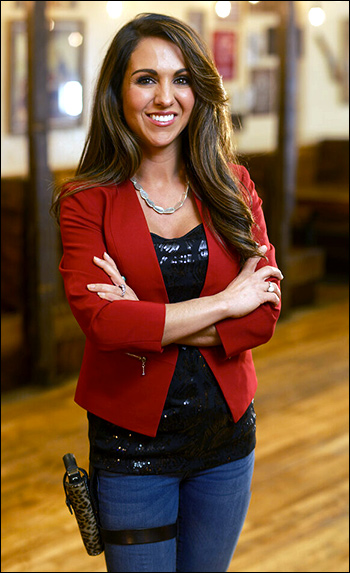By Jim Ellis

2nd Amendment activist, local restaurant owner and now US Rep. Loren Boebert represents Colorado’s 3rd CD.
Already, candidates are lining up, and the most prominent one in the early going announced late last week. State Senate President Pro Tempore Kerry Donovan (D-Gunnison) released a video announcing that she will forego re-election to the state legislature in order to challenge Rep. Boebert in the next congressional campaign. Rancher Gregg Smith and former state House candidate Colin Wilhelm had previously declared their intentions to compete for the Democratic nomination.
Lauren Boebert is a Florida native who moved with her family to the Denver area when she was 12 years old. She then re-located to the Western Slope region in 2003 and, with her husband, opened their restaurant, Shooters Grill, in 2013.
Congresswoman Boebert has attracted much national attention so far with her insistence of carrying a firearm on the House floor. Such is nothing new since she has always holstered a side arm in her restaurant establishment and made defending the 2nd Amendment the cornerstone of her congressional campaign effort.
Despite being heavily outspent, Boebert carried the general election against former state representative and 2018 congressional nominee Diane Mitsch Bush (D) by a 51-45 percent margin, meaning a spread of 26,512 votes. Former President Trump, who recorded only 42 percent of the statewide vote, also carried the 3rd District in a similar 52-46 percent margin.
Because this is a redistricting year, the candidates will battle in a reconfigured 3rd District. Colorado has adopted a congressional redistricting commission, which will operate for the first time later this year. Reapportionment, assuming the Census Bureau announces no further delays in releasing the number of districts each state will house during the decade – now scheduled for April 30 – is expected to award Colorado an eighth seat due to large population growth.
Looking at the current seven districts, all except the 3rd record having more than 800,000 people. Even as the lowest of the current CDs, however, the 3rd will still be forced to shed between 35,000-40,000 residents depending upon the final census numbers. The changes, however, can come only in one direction.
This commonly called Western Slope District is bordered by other states on three sides: Wyoming to the north, Utah in the west, and New Mexico when turning south. Therefore, changes can realistically only come within the district’s eastern border territory, but that stretches the length of the entire state.
Looking at the population density map, the growth region is clearly in the Denver metropolitan area, particularly to the city’s north. In fact, three of the to-10 fastest growing cities in the United States lie in Colorado: Longmont, Greeley, and Denver itself.
What largely makes the 3rd District reasonably competitive is the inclusion of Democratic leaning Pueblo County (Biden: 50-48 percent; Mitsch Bush: 48.1 – 47.8 percent) located approximately 45 miles south of Colorado Springs. As a politically isolated entity surrounded by heavily Republican areas, Pueblo County will likely continue being trapped within this GOP southern region even under the new congressional plan.
Because the population influx is greater at the northern end of the district and state, it appears most of the changes for District 3 will come from Rep. Joe Neguse’s (D-Lafayette/Boulder) 2nd District and/or Rep. Doug Lamborn’s (R-Colorado Springs) 5th CD, seats that will have to shed over 100,000 residents apiece.
The new Colorado Independent Congressional Commission will eventually be comprised of 12 members. A panel of retired judges choose among the applicants for the six public slots, and a half-dozen from the group the state legislature recommends. The six public members were selected last month: two Democrats, two Republicans, and two Unaffiliated voters. The chosen commissioners each come from individual congressional districts and the selected public group has a representative from all but the 2nd CD.
Regardless of the new 3rd District’s shape, we can count on this congressional race attracting national attention, again being expensive, and becoming one of the Democrats’ top conversion targets in their quest to hold the House majority.
